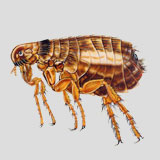Fleas and disease
By Chris Williams on March 9, 2013.
 Think a few fleas on your dog or cat are no big deal? Think again. While fleabites to sensitized dogs and cats can make their lives miserable, (a condition known as flea allergic dermatitis) fleas can be very efficient transmitters of disease causing organisms and also intestinal parasites (tapeworm, and roundworm) to your pets and to YOU!
Think a few fleas on your dog or cat are no big deal? Think again. While fleabites to sensitized dogs and cats can make their lives miserable, (a condition known as flea allergic dermatitis) fleas can be very efficient transmitters of disease causing organisms and also intestinal parasites (tapeworm, and roundworm) to your pets and to YOU!
Without a doubt the most infamous flea-borne disease is plague. The disease is caused by a bacterium (Yersinia pestis) and is spread primarily by the bite of infected Oriental rat fleas. Estimates of up to 25 million deaths were attributed to plague as an epidemic rampaged through Europe during the 14th century. Even today, minor plague outbreaks still do occur throughout the world, (including in some parts of the southwestern U.S.). Fortunately, today’s modern antibiotics have helped to eliminate this disease’s devastating consequences. Though the cat flea (Ctenocephalides felis) is the most common flea species infesting both dogs and cats, it was not previously thought of as a ‘good’ vector for plague, but it has been found infecting feral cat populations in the southwest, and is the main transmitter of plague in certain parts of Africa.
 Another historically significant flea-borne disease is Murine Typhus. This disease is caused by another bacterium, Rickettsia typhi. In most parts of the world where it occurs, the disease is associated with rats and their fleas, but in the US this disease is maintained in reservoirs of feral cats, opossums, rodents, etc, and again carried by the cat flea. Though uncommon now, (less than 100 cases per year in US) during the 1930s’ and 40’s over 40,000 cases were recorded in southern areas of the United States.
Another historically significant flea-borne disease is Murine Typhus. This disease is caused by another bacterium, Rickettsia typhi. In most parts of the world where it occurs, the disease is associated with rats and their fleas, but in the US this disease is maintained in reservoirs of feral cats, opossums, rodents, etc, and again carried by the cat flea. Though uncommon now, (less than 100 cases per year in US) during the 1930s’ and 40’s over 40,000 cases were recorded in southern areas of the United States.
Yet another flea-borne illness associated with the cat flea (Ctenocephalides felis) is cat scratch disease (CSD). This is a disease caused by the bacterium Bartonella henselae. Cats become infected with Bartonella resulting from bites by infected fleas. These infected cats can transmit the disease to humans through bites or scratches. It is possible that infected fleas themselves could transmit the disease directly to humans. About 25,000 cases of cat-scratch are diagnosed each year and although treatable, complications from infections by Bartonella can be very serious in young children and immune compromised individuals (source)
Where dogs seem to be unscathed with regard to disease transmission by fleabites, (ticks are much more important) they can easily pick up tapeworm by ingesting fleas through biting or grooming. Severe flea infestations in dogs can lead to anemia. http://www.animalhealth.bayer.com/4813.0.html
Make no mistake; flea infestations on your pets can be a very big deal both for their health and yours.
Sources: